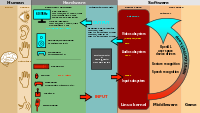
Photo from wikipedia
This paper sets out to consider the relationship between design education, architects’ colour knowledge, colour orientations and colour use in design practice. Specifically, a survey of 274 architects, architectural academics… Click to show full abstract
This paper sets out to consider the relationship between design education, architects’ colour knowledge, colour orientations and colour use in design practice. Specifically, a survey of 274 architects, architectural academics and postgraduates in Australia and Iran addressed the questions—is design education informing colour knowledge, and does colour education and knowledge inform an architect’s colour use in their designs? The findings suggest colour use in architecture has two chief influences: (1) Colour Orientation (architects’ general attitudes and prejudices towards colour use); and (2) Contextual Variables (the cultural and physical context of designs). The study shows that while the amount of colour education that architects receive has little role in informing their colourfulness orientations (i.e., how colourful they believe architecture in general should be), the greater an architect’s colour knowledge the more colourful their designs will be. The study suggests that the colourfulness of contemporary buildings is likely influenced more by levels of architects’ theoretical colour knowledge and by their personal preferences rather than by contextual influences such as the cultural and physical context of a design, the building function, or client directives.
Journal Title: International Journal of Technology and Design Education
Year Published: 2018
Link to full text (if available)
Share on Social Media: Sign Up to like & get
recommendations!